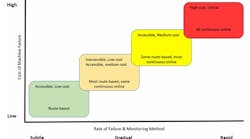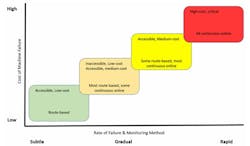Can you believe the amount of information accessible from that smartphone in your hand? In the span of a few years, smartphone users have almost forgotten the amount of work required to retrieve the name of "that actor in that recent movie,” locate the nearest coffee shop, or find a ride. This same transition is now underway with machine monitoring, where companies are seeing the potential of that small device in our hands, and are considering how to apply such instant data access to improving the performance and condition of their mechanical and electrical assets.
Resources
Fog Computing and Its Role in the Internet of Things.
F. Bonomi, R. Milito, J. Zhu, and S. Addepalli, 2012. plnt.sv/1508AZ1
Condition Monitoring of Wind Turbines.
C. McGowin, EPRI, 2006. plnt.sv/1508AZ2
Condition Monitoring Systems: Trends and Cost Benefits.
M. LeBlanc and A. Graves, GL Garrad Hassan, 2011. plnt.sv/1508AZ3
Machines often fail randomly; according to Allied Reliability Group, roughly 90% of failures are unexpected. For this reason, plant maintenance and reliability is going to benefit greatly from powerful small devices that can continuously monitor assets and help reduce the number of failures. This raises a question: is the ability to collect condition data both continuously and cost-effectively within reach for most companies?
Continuous monitoring technologies have established their value in the wind turbine sector. For example, a 2006 study by the Electric Power Research Institute (EPRI) found that when a condition monitoring system detects signs of potential failure early and therefore avoids a major failure and the resulting repair costs, the estimated cost savings are $75,000 to $225,000 per event for megawatt-scale turbines, depending on the turbine rating and extent of damage. In comparison, the cost of a “high-end” condition monitoring system is about $20,000, which is more than offset by the cost-avoidance savings associated with even one failure. A separate 2011 study by GL Garrad Hassan Renewable Energy Consultants found that continuous monitoring reduced turbine downtime from 14 days to 4, and estimated a savings of $175,000 to repair the gearbox instead of a full preventative replacement of it.
The cost to deploy continuous monitoring devices on the manufacturing floor should be compared against traditional “route-based” measurements, which typically include vibration levels and frequencies, oil analysis, motor current analysis, and thermal signatures. The answer depends on the cost of downtime and repair, as the costs of downtime and machine replacement scale with criticality (Figure 1). If continuous monitoring detects one of these “random” between periodic route-based measurements, then the cost of the online monitoring equipment instantly pays for itself many times over, especially if the machine is particularly expensive and/or is critical to operations.
Fortunately, the cost of monitoring equipment is being reduced everyday due to the economic pressures driven by the growing numbers of Internet-connected consumer products. Furthermore, once the monitoring device is in place, adding intelligence is a natural next step, since monitoring devices are built with powerful processors. Then, signal and numeric processing can be used to make decisions at the machine, and promoting measurements to a supervisory application or person is unnecessary. This price and performance trend is motivating companies to continuous monitoring as an alternative to route-based approaches.
Two major trends are evolving quickly to help users manage and analyze the large amount of data produced by smart monitoring devices: the Industrial Internet of Things (IIoT) and data analytics. Even though measurement devices have been transmitting data remotely for decades, the industrial world is abuzz with the potential of connecting huge numbers of measurement devices to the Internet cloud, allowing measurements to be aggregated from multiple data sources in ways that will enable machines to be better maintained than ever before. This technology is labeled with terms like Big Data, Industrie 4.0, and Industrial Internet of Things.
Cloud-based analytics often seems a required part of systems configured for the IIoT. Not so. In the past few years, the IIoT crowd has promoted a design that pushes computing and analysis closer to the machines, a design termed fog computing. Manufacturers are increasingly driving towards these fog computing and IIoT technologies to improve equipment efficiency and reliability and to enhance uptime and maintenance scheduling. Also, as increasing numbers of machines are continuously monitored, the huge volume of data will require that machines become “smart” and able to make decisions locally.
To drive enhanced machine reliability, methodologies already in use for business-driven analytics need to be applied to smart systems. These analytic methods are:
- Descriptive: Covers the traditional data collection and trending analysis of machine health, such as trending overall RMS over a period of months.
- Predictive: Forecasts the future based on individual and combinations of multiple descriptive parameters to estimate forthcoming events.
- Prescriptive: Combines the output of the predictive analysis with considerations on the cost and value benefits of choosing a specific maintenance path. Business measures need to be integrated into these analyses, and will affect the decision regarding the reliability and maintenance of a particular machine.
Because each analysis adds to the previous, additional data and computation are required. Hence, the smarter the system connected to the manufacturing machines, the better the decision making.
Also, several platforms exist for performing data collection and Descriptive analysis, such as from GE Bently Nevada, Emerson CSI, National Instruments (NI), and SKF. Generally, these companies provide tools for both route-based and continuous online data collection.
In summary, each generation of consumer smart devices is more small, capable, and inexpensive than the prior version. Machine reliability will improve through continuous measurements and enhanced analytics. We have exciting times ahead.
A few studies highlight the benefits of continuous monitoring for plant and machine reliability and maintenance.
EPRI Study 1
When a condition monitoring system detects signs of potential failure early and therefore avoids a major failure and the resulting repair costs, the estimated cost savings are $75,000 to $225,000 per event for megawatt-scale turbines, depending on the turbine rating and extent of damage. In comparison, the cost of a “high-end” condition monitoring system is about $20,000, which would be more than offset by these savings.
A study on transformer condition monitoring by Southern California Edison presented at the 2006 EPRI conference indicated that “early retirement” of transformers based on a scheduled replacements can waste several hundred thousand dollars per year. A better plan includes periodic monitoring to determine the portion of available life remaining in the equipment. Furthermore, the additional operating years result in a substantial amount of deferred capital expense.
GL Garrad Hassan Renewable Energy Consultants discussed in Oct 2011 at an NREL Conference the use of a Continuous Monitoring System (CMS) on wind turbines.
• Corrective gearbox replacement $415k
• No CMS:
o Preventative gearbox replacement cost $405k
• CMS that detect problems
o Limit damage to single stage of gearbox $280k
• CMS that interfaces with operating system of wind turbine
o Prevents the damage all together $0
• Repair times are also shorter:
o Corrective: 14 days down
o Preventative: 4 days down
GE Industrial Data Intelligence
Jeremiah Stone, General Manager of GE’s Industrial Data Intelligence Software business unit, discusses the use of monitoring slight deviations from normal fluctuation ranges in Oil and Gas equipment for Remote Monitoring and Diagnostics (RM&D). The algorithms incorporated in GE’s RM&D found early warning signs despite significant noise, thus preventing potential false alarms.


